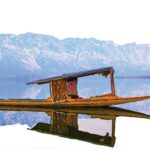When we think of Asiatic lions, the first place that comes to mind is the Gir National Park in Gujarat, the only natural habitat of this majestic species. However, in recent years, these lions have begun exploring a new lifestyle — venturing beyond the forest into the coastal belts of Gujarat. From mangroves to beaches, the kings of Gir seem to be enjoying a seaside kingdom.
This fascinating shift raises curiosity: why are lions moving to coastal regions, and how does it affect conservation and tourism?
The Gir Lions’ New Coastal Territory

Traditionally, Asiatic lions were confined to the dry deciduous forests of Gir. But today, sightings have been reported along Gujarat’s coastal districts such as Amreli, Bhavnagar, Junagadh, and Gir-Somnath. Lions have been spotted near:
- Beaches and mangrove belts
- Salt pans and fishing villages
- River mouths and coastal farmlands
This adaptation shows the resilience of Asiatic lions and how they are thriving beyond their conventional habitat.
Why Are Lions Moving Towards the Coast?
There are several reasons behind this coastal shift:
- Population Growth – The number of Asiatic lions has increased steadily, and their home range has expanded beyond Gir.
- Food Availability – Coastal regions offer livestock, wild boar, blue bulls, and even marine ecosystem prey.
- Habitat Expansion – Mangroves and scrublands provide new cover and hunting grounds.
- Reduced Competition – Moving away from dense lion zones reduces competition among prides.
Coastal Life: A New Chapter in Lion Behavior
The sight of lions walking calmly on sandy shores surprises many. But for locals, it has become an extraordinary yet natural part of daily life. Fishermen sometimes encounter lions near boats or salt pans, creating a unique human-wildlife interaction.
This coastal adaptation also highlights the ecological balance of Gujarat, where lions coexist not only with villagers but also with the Arabian Sea.
Impact on Tourism in Gujarat
For wildlife lovers, this development adds a new dimension to Gujarat tourism. Travelers now have a chance to witness lions not just in Gir forest safaris, but also in coastal landscapes.
Imagine spotting a lion pride strolling along mangroves with the sea breeze in the background — it’s a wildlife experience unlike anywhere else in the world.
Tour operators are exploring ways to integrate these sightings with eco-tourism while ensuring that lion conservation remains a top priority.
Conservation Challenges Ahead
While coastal lion life is fascinating, it also brings challenges:
- Human-Lion Conflict – Increased interaction with fishermen and coastal villagers may lead to conflicts.
- Marine & Industrial Activity – Ports, salt industries, and coastal development can disturb lion habitats.
- Safety Concerns – Open coastal regions may expose lions to accidents and poaching risks.
To balance conservation and tourism, the Gujarat Forest Department has launched monitoring projects and awareness programs among coastal communities.
Conclusion
The Asiatic lions of Gujarat are rewriting their story — from forest kings to coastal wanderers. Their adaptability proves not only the strength of the species but also the richness of Gujarat’s ecosystems.
For travelers, it means a new way to experience wildlife tourism, blending beaches with big cats. For conservationists, it is a reminder of the need to protect both forests and coasts.






